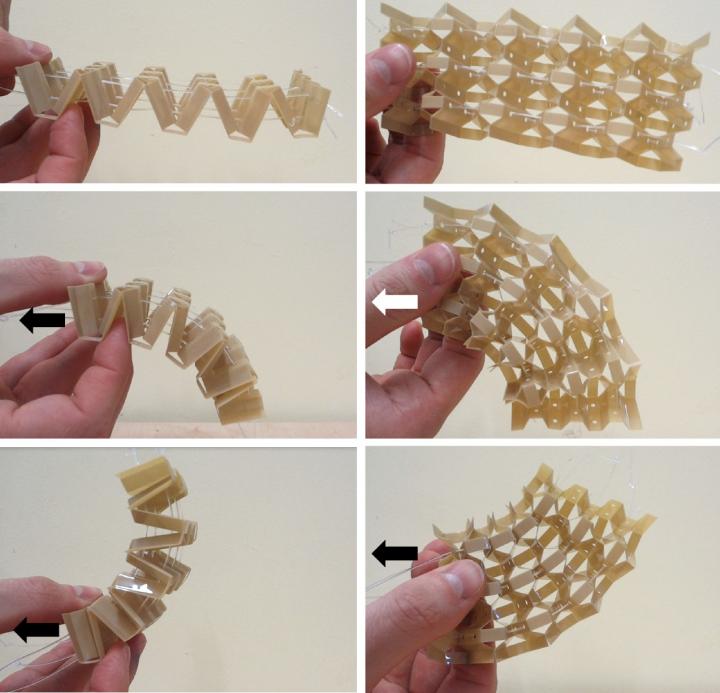Shape-changing metamaterial developed using Kirigami technique

This is a demonstrator honeycomb changing shape in response to cable tension. The arrows indicate which cable is being pulled Credit: University of Bristol
Metamaterials are a class of material engineered to produce properties that don't occur naturally. Currently metamaterials are used to make artificial electromagnetic and vibration absorbers and high-performance sensors. Kirigami can be applied to transform two-dimensional sheet materials into complex three-dimensional shapes with a broader choice of geometries than 'classical' origami.
The research, developed within a PhD programme run by the University's EPSRC Centre for Doctoral Training in Advanced Composites for Innovation and Science (ACCIS CDT), is published today in Scientific Reports.
The type of mechanical metamaterials using the Kirigami technique, developed by PhD student Robin Neville, changes shape seamlessly, exhibits large variations in mechanical performance with small geometry changes, and can be adapted to modify its configuration by using mainstream actuation mechanisms.
The Kirigami metamaterial can also be produced using off-the-shelf thermoplastic or thermoset composite materials, and different sensing and electronics systems can be embedded to obtain a fully integrated smart shape-changing structure.
Fabrizio Scarpa, Professor of Smart Materials and Structures in the Department of Aerospace Engineering and ACCIS, said: “Mechanical metamaterials exhibit unusual properties through the shape and deformation of their engineered subunits. Our research presents a new investigation of the kinematics of a family of cellular metamaterials based on Kirigami design principles. This technique allows us to create cellular structures with engineered cuts and folds that produce large shape and volume changes, and with extremely directional, tuneable mechanical properties.”
Robin Neville, PhD student, added: “By combining analytical models and numerical simulations we have demonstrated how these Kirigami cellular metamaterials can change their deformation characteristics. We have also shown the potential of using these classes of mechanical metamaterials for shape change applications like morphing structures.”
In the future, this Kirigami metamaterial could be used in robotics, morphing structures for airframe and space applications, microwave and smart antennas.
###
Paper
'Shape morphing Kirigami mechanical metamaterials' by Robin M. Neville, Fabrizio Scarpa and Alberto Pirrera in Scientific Reports [open access]
Media Contact
All latest news from the category: Power and Electrical Engineering
This topic covers issues related to energy generation, conversion, transportation and consumption and how the industry is addressing the challenge of energy efficiency in general.
innovations-report provides in-depth and informative reports and articles on subjects ranging from wind energy, fuel cell technology, solar energy, geothermal energy, petroleum, gas, nuclear engineering, alternative energy and energy efficiency to fusion, hydrogen and superconductor technologies.
Newest articles

Silicon Carbide Innovation Alliance to drive industrial-scale semiconductor work
Known for its ability to withstand extreme environments and high voltages, silicon carbide (SiC) is a semiconducting material made up of silicon and carbon atoms arranged into crystals that is…

New SPECT/CT technique shows impressive biomarker identification
…offers increased access for prostate cancer patients. A novel SPECT/CT acquisition method can accurately detect radiopharmaceutical biodistribution in a convenient manner for prostate cancer patients, opening the door for more…

How 3D printers can give robots a soft touch
Soft skin coverings and touch sensors have emerged as a promising feature for robots that are both safer and more intuitive for human interaction, but they are expensive and difficult…





















